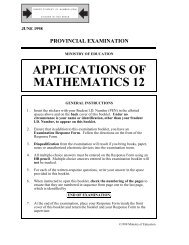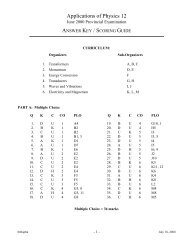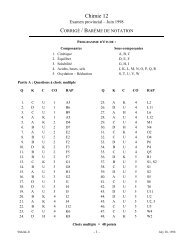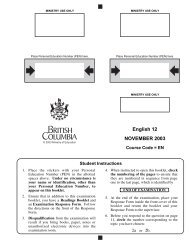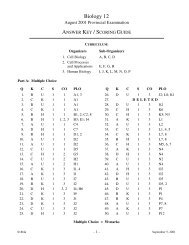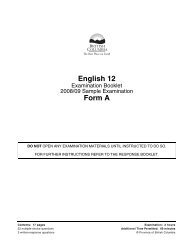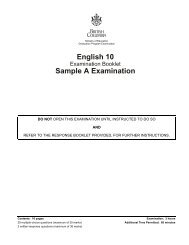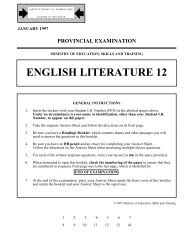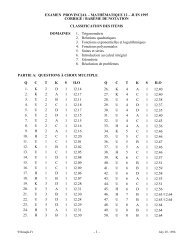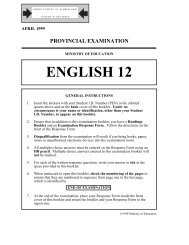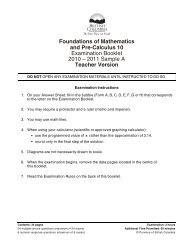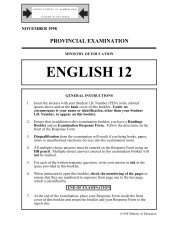English 12 - QuestionBank.CA
English 12 - QuestionBank.CA
English 12 - QuestionBank.CA
You also want an ePaper? Increase the reach of your titles
YUMPU automatically turns print PDFs into web optimized ePapers that Google loves.
<strong>English</strong> <strong>12</strong><br />
June 2002 Provincial Examination<br />
ANSWER KEY / SCORING GUIDE<br />
Topics: 1. Editing, Proofreading and Comprehension Skills<br />
2. Interpretation of Literature<br />
3. Original Composition<br />
Multiple Choice<br />
Q K C S T<br />
1. C K 1 1<br />
2. A K 1 1<br />
3. A K 1 1<br />
4. D K 1 1<br />
5. B K 1 1<br />
6. B K 1 1<br />
7. A K 1 1<br />
8. B K 1 1<br />
9. C K 1 1<br />
10. B K 1 1<br />
11. B K 1 1<br />
<strong>12</strong>. D K 1 1<br />
13. A U 1 1<br />
14. B K 1 2<br />
15. D K 1 2<br />
Q K C S T<br />
16. A U 1 2<br />
17. D U 1 2<br />
18. A K 1 2<br />
19. A U 1 2<br />
20. D U 1 2<br />
21. B K 1 2<br />
22. B U 1 2<br />
23. B K 1 2<br />
24. B K 1 2<br />
25. D K 1 2<br />
26. C U 1 2<br />
27. B U 1 2<br />
28. D U 1 2<br />
29. A U 1 2<br />
30. D K 1 2<br />
Multiple Choice = 30 marks<br />
0206enk - 1 - July 23, 2002
Written Response<br />
Q C T S<br />
1. H 2 <strong>12</strong><br />
2a. H 2 24<br />
2b. H 2 24<br />
⎫<br />
⎬<br />
⎭<br />
Score only one of the<br />
two questions given.<br />
3. H 3 24<br />
Written Response = 60 marks<br />
Multiple Choice = 30<br />
Written Response = 60<br />
EXAMINATION TOTAL = 90 marks<br />
LEGEND:<br />
Q = Question Number C = Cognitive Level T = Topic<br />
K= Keyed Response S = Score B= Score Box Number<br />
0206enk - 2 - July 23, 2002
POETRY SCORING GUIDE<br />
This question tests both the reading and the writing abilities of the student. Your mark must reflect both<br />
the accuracy of the reading as well as the fluency of the writing.<br />
This guide should be adequate for most papers; however, if you come across a paper that is problematic,<br />
please double-check with the chair or sub-chair. It is essential to remember that this is a draft work; even<br />
high-level papers are likely to have the odd error — whether in analysis or writing. Such mistakes should<br />
be considered as part of the paper’s holistic mark, but should not necessarily result in an automatic drop in<br />
the score. However, a paper containing errors so distracting that they impede understanding should not be<br />
given a mark of more than three; a two would be more likely.<br />
Please remember that references to the text may be explicit or implicit. References to lines solely by<br />
number should be ignored.<br />
High-level papers are proficient in clearly articulating the theme of the poem as well as in using examples<br />
or quotations demonstrating the poet’s use of imagery to convey theme.<br />
Mid-range papers tend to contain a weak statement of theme with adequate support, often in the form of a<br />
list of images.<br />
Low-level papers tend to discuss theme in vague terms with at least some reference to imagery.<br />
0206enk - 3 - July 23, 2002
6 Answer<br />
The six response meets all the criteria of a five: its superiority to the five response is a result of degree, not<br />
kind. The level of insight may be particularly convincing and/or subtle or the writing exceptionally<br />
impressive. Certainly the six response exhibits a depth of understanding and a sophisticated use of<br />
language.<br />
5 Answer<br />
The five response reflects a strong grasp of the topic and the poem. The references to the poem may be<br />
explicit or implicit and convincingly support the student’s point of view. In both understanding and<br />
writing, the paper is proficient. The writing is well organized and reflects a strong grasp of the conventions<br />
of language.<br />
4 Answer<br />
The four response is competent. Understanding of the poem is accurate but rather superficial or somewhat<br />
incomplete, certainly not imaginative. References are present and suitable, but may be limited to only part<br />
of the poem. The writing conveys the student’s views in an organized, straightforward fashion; errors are<br />
present but generally not distracting. Overall, the student has good control of the conventions of language.<br />
3 Answer<br />
The three response is barely adequate. While the student’s treatment of the topic may not be wrong, it<br />
may be incomplete or so superficial as to seem inaccurate. While a central idea may not be clearly stated,<br />
it is present or implied and at least partially supported. Support may consist of long references to the poem<br />
which are not clearly connected to a central idea; alternatively, support may be very meagre and/or<br />
replaced by repetitive statements. Organization is present, but may not directly help the flow of ideas.<br />
There are lapses in the student’s control over the conventions of language.<br />
2 Answer<br />
The two response reflects a significant misunderstanding of the poem and/or the task required by the<br />
question. The discussion may be irrelevant, seriously incomplete, or simply wrong. Errors are recurring<br />
and distracting. In some cases, the marker may sense that the student has grasped the essence of the<br />
question but has such deficiencies in language as to render the explanation seriously compromised.<br />
1 Answer<br />
A one response compounds the problems of the two paper. These papers are often noticeably weaker in<br />
their prose. There is a serious lack of control in the writing; in fact, the marker may wonder, at times,<br />
what the writer is trying to say. Other one papers are little more than a restatement of the topic.<br />
0 Answer<br />
A response with less than a complete sentence, or written in verse, or a response manifesting an<br />
achievement less than outlined in scale point 1.<br />
A blank paper with no response given.<br />
NR<br />
0206enk - 4 - July 23, 2002
PART B: POETRY<br />
The Quarter Horse Colts<br />
(page 1 in the Readings Booklet)<br />
INSTRUCTIONS:<br />
In paragraph form and in approximately <strong>12</strong>5 to 150 words, answer question 1 in the<br />
space provided. Write in ink. The mark for your answer will be based on the<br />
appropriateness of the example(s) you use as well as the adequacy of your<br />
explanation and the quality of your written expression.<br />
1. The poet makes extensive use of imagery. In paragraph form and with reference to the poem,<br />
discuss how imagery contributes to theme.<br />
(<strong>12</strong> marks)<br />
Suggestions Regarding Response:<br />
Theme<br />
• There is joy in the renewal of life.<br />
• There is beauty in nature.<br />
• Youth is a time of innocence.<br />
• There is contrast between the experienced<br />
and the innocent.<br />
Imagery<br />
(l. 5, 7–9, 20–21)<br />
(l. 5, 6, 17)<br />
(l. 8–9, 10–11, 21–22)<br />
(l. 10–15, 21–22)<br />
This list is not exhaustive.<br />
The exemplars will provide sample responses.<br />
Marks will be awarded for content and written expression.<br />
Refer to the Holistic Scale on pages 3 and 4 of this key.<br />
0206enk - 5 - July 23, 2002
PROSE SCORING GUIDE FOR QUESTION 2A<br />
This guide is specific to narrative reading passages. This question tests both the reading and the writing<br />
abilities of the student. Your mark must reflect both the accuracy of the reading as well as the fluency of<br />
the writing.<br />
This guide should be adequate for most papers; however, if you come across a paper that is problematic,<br />
please double-check with the chair or sub-chair. It is essential to remember that this is a draft work; even<br />
high-level papers are likely to have the odd error — whether in analysis or writing. Such mistakes should<br />
be considered as part of the paper’s holistic mark, but should not necessarily result in an automatic drop in<br />
the score. However, a paper containing errors so distracting that they impede understanding should not be<br />
given a mark of more than three; a two would be more likely.<br />
Essays which are not multi-paragraph will be deducted one scale point. Please remember that<br />
references to the text may be explicit or implicit. References to paragraphs solely by number should<br />
be ignored.<br />
High-level papers understand the elements of setting and conflict and the contribution they make to each<br />
other. The students show an understanding of both the external and internal conflict.<br />
Mid-range papers tend to present a catalogue of the more obvious elements of the story to support their<br />
ideas. The entire story may not be discussed. Analysis may be compromised by a reliance on plot<br />
summary.<br />
Low-level papers show no recognition of conflict but emphasize the setting, therefore the relationship is<br />
not developed.<br />
0206enk - 6 - July 23, 2002
6 Answer<br />
The six essay meets all the criteria of a five: its superiority to the five essay is a result of degree, not kind.<br />
The level of insight may be particularly convincing and/or subtle or the writing exceptionally impressive.<br />
Certainly the six essay exhibits a depth of understanding and a sophisticated use of language.<br />
5 Answer<br />
The five essay reflects a strong grasp of the text. The response has a clearly stated thesis which is<br />
convincingly supported. In both understanding and writing, the paper is proficient. The essay reflects a<br />
strong grasp of the conventions of language.<br />
4 Answer<br />
The four essay is competent. References are present and suitable, but may be limited to only part of the<br />
text. The assertions in the four essay tend to be simplistic. There are no significant errors in reading. The<br />
writing is able to convey the writer’s views in an organized, straightforward fashion; errors are present but<br />
generally not distracting. Overall, the student has good control of the conventions of language.<br />
3 Answer<br />
The three essay’s response is barely adequate. While the student’s treatment of the topic may not be<br />
wrong, it may be incomplete or so superficial as to seem inaccurate. While a central idea may not be<br />
clearly stated, it is present or implied and at least partially supported. Support may consist of long<br />
references to the prose which are not clearly connected to a central idea; alternatively, support may be very<br />
meagre and/or replaced by repetitive statements. Organization is present, but may not directly help the<br />
flow of ideas. There are lapses in the student’s control over the conventions of language.<br />
2 Answer<br />
The two essay’s response reflects a significant misunderstanding of the story and/or the task required by<br />
the question. The discussion may be irrelevant, seriously incomplete, or simply wrong. Composition<br />
errors are recurring and distracting. In some cases, the marker may sense that the student has grasped the<br />
essence of the question but has such deficiencies in language as to render the explanation seriously<br />
compromised.<br />
1 Answer<br />
The one essay compounds the problems of the two essay. These papers are often noticeably weaker in<br />
their prose. There is a serious lack of control in the writing; in fact, the marker may wonder, at times,<br />
what the writer is trying to say. Other one papers are little more than a restatement of the topic.<br />
0 Answer<br />
A response with less than a complete sentence, or written in verse, or a response manifesting an<br />
achievement less than outlined in scale point 1.<br />
A blank paper with no response given.<br />
NR<br />
0206enk - 7 - July 23, 2002
PART C: PROSE<br />
Taseko<br />
(pages 2 to 4 in the Readings Booklet)<br />
INSTRUCTIONS:<br />
Choose one of the following two topics and write a multi-paragraph essay of<br />
approximately 300 words. Write in ink. The mark for your answer will be based<br />
on the appropriateness of the example(s) you use as well as the adequacy of your<br />
explanation and the quality of your written expression. Value: 24 marks<br />
2a. In multi-paragraph essay form and with reference to the story, discuss how the setting<br />
contributes to the element of conflict.<br />
(24 marks)<br />
Suggestions Regarding Response:<br />
Setting<br />
(para. 1–2) moves to the hunting ground;<br />
“fading radio”, “climbed higher”<br />
(para. 4) “road becomes two ruts”<br />
(para. <strong>12</strong>–13) “Just there, beyond the firelight,<br />
was the wild…”; “…each day it grew colder…”<br />
(para. 14) “ two inches of snow”, “grey clouds<br />
were banked above the mountains”<br />
(para. 19) boy’s growing awareness;<br />
“unfolding solitude”<br />
(para. 8–10) “worked the higher ridges”<br />
(para. 5–7) “icy wind”, “fingers numbed”<br />
(para. 19–21) “snow and wind rising, spirits<br />
moaning in the timber”, “Icy branches clawed”<br />
(para. 24) “followed them through the darkness”<br />
Conflict<br />
Leaving boyhood; threshold between boyhood<br />
and manhood<br />
Sense of isolation; remoteness<br />
They are intruders; they are worn down by lack<br />
of success.<br />
The men are forced into a decision; increases<br />
the tension.<br />
Highlights the boy’s internal struggle about<br />
hunting.<br />
Hunting in an inhospitable environment<br />
They are fighting the elements and the<br />
unknown.<br />
This list is not exhaustive.<br />
The exemplars will provide sample responses.<br />
Marks will be awarded for content and written expression.<br />
Refer to the Holistic Scale on pages 6 and 7 of this key.<br />
0206enk - 8 - July 23, 2002
PROSE SCORING GUIDE FOR QUESTION 2B<br />
This guide is specific to narrative reading passages. This question tests both the reading and the writing<br />
abilities of the student. Your mark must reflect both the accuracy of the reading as well as the fluency of<br />
the writing.<br />
This guide should be adequate for most papers; however, if you come across a paper that is problematic,<br />
please double-check with the chair or sub-chair. It is essential to remember that this is a draft work; even<br />
high-level papers are likely to have the odd error — whether in analysis or writing. Such mistakes should<br />
be considered as part of the paper’s holistic mark, but should not necessarily result in an automatic drop in<br />
the score. However, a paper containing errors so distracting that they impede understanding should not be<br />
given a mark of more than three; a two would be more likely.<br />
Essays which are not multi-paragraph will be deducted one scale point. Please remember that<br />
references to the text may be explicit or implicit. References to paragraphs solely by number should<br />
be ignored.<br />
High-level papers tend to see the boy as an everyman, and his experiences as universal. Many identify the<br />
boy’s realization that conformity, though expected is a questionable process.<br />
Mid-range papers tend to list the boy’s experiences without showing a connection between these<br />
experiences and the protagonist’s coming of age.<br />
Low-level papers do not understand the meaning of conformity and so fell into plot summary.<br />
0206enk - 9 - July 23, 2002
6 Answer<br />
The six essay meets all the criteria of a five: its superiority to the five essay is a result of degree, not kind.<br />
The level of insight may be particularly convincing and/or subtle or the writing exceptionally impressive.<br />
Certainly the six essay exhibits a depth of understanding and a sophisticated use of language.<br />
5 Answer<br />
The five essay reflects a strong grasp of the text. The response has a clearly stated thesis which is<br />
convincingly supported. In both understanding and writing, the paper is proficient. The essay reflects a<br />
strong grasp of the conventions of language.<br />
4 Answer<br />
The four essay is competent. References are present and suitable, but may be limited to only part of the<br />
text. The assertions in the four essay tend to be simplistic. There are no significant errors in reading. The<br />
writing is able to convey the writer’s views in an organized, straightforward fashion; errors are present but<br />
generally not distracting. Overall, the student has good control of the conventions of language.<br />
3 Answer<br />
The three essay’s response is barely adequate. While the student’s treatment of the topic may not be<br />
wrong, it may be incomplete or so superficial as to seem inaccurate. While a central idea may not be<br />
clearly stated, it is present or implied and at least partially supported. Support may consist of long<br />
references to the prose which are not clearly connected to a central idea; alternatively, support may be very<br />
meagre and/or replaced by repetitive statements. Organization is present, but may not directly help the<br />
flow of ideas. There are lapses in the student’s control over the conventions of language.<br />
2 Answer<br />
The two essay’s response reflects a significant misunderstanding of the story and/or the task required by<br />
the question. The discussion may be irrelevant, seriously incomplete, or simply wrong. Composition<br />
errors are recurring and distracting. In some cases, the marker may sense that the student has grasped the<br />
essence of the question but has such deficiencies in language as to render the explanation seriously<br />
compromised.<br />
1 Answer<br />
The one essay compounds the problems of the two essay. These papers are often noticeably weaker in<br />
their prose. There is a serious lack of control in the writing; in fact, the marker may wonder, at times,<br />
what the writer is trying to say. Other one papers are little more than a restatement of the topic.<br />
0 Answer<br />
A response with less than a complete sentence, or written in verse, or a response manifesting an<br />
achievement less than outlined in scale point 1.<br />
A blank paper with no response given.<br />
NR<br />
0206enk - 10 - July 23, 2002
2b. In multi-paragraph essay form and with reference to the story, discuss how the boy attempts to<br />
conform to the expectations of the adult hunters.<br />
(24 marks)<br />
Suggestions Regarding Response:<br />
• He wishes his mother had not singled him out with her waving. (para. 1)<br />
• The boy sets up the tent in the cold to please his father. (para. 5)<br />
• He is first up; ready for action; anxious to contribute. (para. 7)<br />
• The boy is proud, though leery, of his gun. (para. 9)<br />
• The boy watches and follows his father’s lead. (para. 9–11)<br />
• Listens to the men; trusts their judgment without question. (para. 11)<br />
• The boy sensed that his father wanted to please him, and he wanted to please his father.<br />
(para. 16)<br />
• He begins to experience discomfort, but continues on. (para. 19–20)<br />
• He does what is expected, and shoulders the rack, despite his unease. (para. 24)<br />
This list is not exhaustive.<br />
The exemplars will provide sample responses.<br />
Marks will be awarded for content and written expression.<br />
Refer to the Holistic Scale on pages 9 and 10 of this key.<br />
0206enk - 11 - July 23, 2002
Value: 24 marks<br />
INSTRUCTIONS:<br />
PART D: ORIGINAL COMPOSITION<br />
Suggested Time: 40 minutes<br />
Using standard <strong>English</strong>, write a coherent, unified, multi-paragraph composition of<br />
approximately 300 words on the topic below. In your composition, you may apply<br />
any effective and appropriate method of development which includes any<br />
combination of exposition, persuasion, description, and narration.<br />
Use the page headed Organization and Planning for your rough work. Write your<br />
composition in ink on the pages headed Finished Work.<br />
3. Write a multi-paragraph composition on the topic below. In addressing the topic, you may<br />
draw support from the pictures below, the experiences of others, or from any aspect of your<br />
life: your reading, your own experiences, and so on.<br />
Topic:<br />
People can be influenced by their environment.<br />
0206enk - <strong>12</strong> - July 23, 2002
SCORING GUIDE FOR ORIGINAL COMPOSITION (PART D)<br />
A composition may apply any effective and appropriate method of development which includes any<br />
combination of exposition, persuasion, description, and narration. No one form of writing should be<br />
considered superior to another. Compositions that are not multi-paragraph will be deducted one<br />
scale point.<br />
6<br />
The 6 paper meets all the criteria for a 5 paper, and it is superior and/or exceptionally engaging. In<br />
addition, the paper may draw upon any number of factors: maturity of style, effectiveness of argument,<br />
use of literary and/or rhetorical devices, depth of discussion, sophistication of wit, or quality of<br />
imagination.<br />
5<br />
The 5 paper is an example of proficient writing. It displays some manipulation of language to achieve a<br />
desired effect. It exhibits a strong voice and clear sense of audience. Content is thoughtful and<br />
interesting. Any errors which are present do not detract from the reader’s understanding. Vocabulary and<br />
sentence structure are varied and serve the author’s purpose successfully.<br />
4<br />
The 4 paper is clearly adequate. The prose is able to convey the writer’s ideas, but without flair or strong<br />
control. Diction and syntax are usually appropriate, but lack variety. Structure, regardless of type, is<br />
predictable and relatively mechanical. The reader has a clear sense of the writer’s purpose, but is not<br />
engaged by the prose. Conventions of language are usually followed, but the reader is aware of errors.<br />
3<br />
The 3 paper is barely adequate. The paper features underdeveloped paragraphs. Transition may be weak<br />
or absent. Support for obvious and simplistic ideas is frequently in the form of listed details. Little<br />
variety in diction and sentence structure is discernible. Although the reader may be aware of some<br />
purpose, errors impede the fluency of the paper.<br />
2<br />
The 2 paper shows familiarity with common spoken language in casual conversation or in the writing of<br />
one not fully conversant with the language. It sustains a subject focus with some unity of direction.<br />
Underdeveloped ideas are simply and/or awkwardly expressed, as they might be in casual conversation.<br />
The paper reflects little knowledge of the conventions of language; errors are frequent and rudimentary.<br />
The reader can perceive meaning and detect a purpose emerging.<br />
1<br />
The 1 paper is so compromised by its brevity and its deficiency of composition, content, diction, syntax,<br />
structure, voice and conventions of language as to render its meaning/purpose almost unintelligible.<br />
0<br />
A paper with less than a complete sentence, or written in verse, or a paper manifesting an achievement<br />
less than outlined in scale point 1.<br />
A blank paper with no response given.<br />
NR<br />
END OF KEY<br />
0206enk - 13 - July 23, 2002



